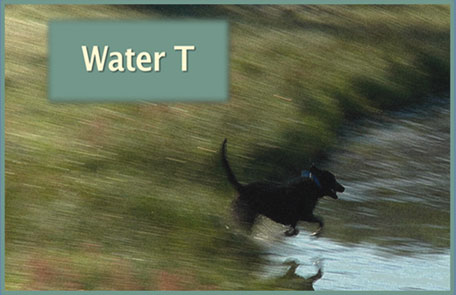 WATER T WATER T
The idea is to get the dog going back and forth to a pile of bumpers in the water. Once a dog is driving for the pile, understands it well, then there are three components of collar reinforcement that are needed to complete Water T:
1. The dog accepts a nick from your side
2. The dog accepts a nick in route.
3. The dog accepts a nick with the whistle/sit when stopped and cast to the back pile
It doesn’t matter how long this takes as each dog is different. Bill throws out extra bumpers to KEEP THE DRIVE ALIVE! Bill demonstrates practicing whistle stops on land with collar reinforcement before stopping the dog in the water, as dogs can be hard to stop in the water once they develope the power. Bill wants to keep the momentum at a peak. For those dogs that are challenging to stop on the whistle in the water Bill shows how it’s done with a rope. To introduce the over cast, Bill whistle stops the dog, tosses a bumper near the pile he starts casting to and then casts. In the process Bill wants the dog to constantly make the dog think it’s fun and a game. “It should never be drudgery, they should never get scared, they should always think I’m glad I”m out here today.” Bill believes the way we teach dogs is by handling, so if they don’t handle very well it’s going to be hard to teach them what you want them to know. He teaches by handling and repetition, not by experimentation and experience. The powercast is reviewed just before starting swimby.
|
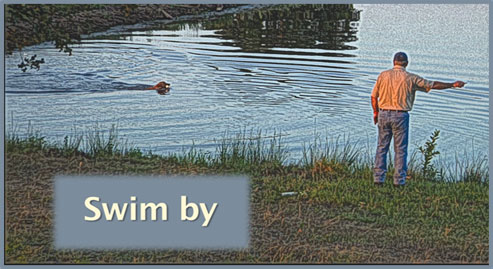 SWIM BY SWIM BY
Once you have convinced yourself that Water T is finished and correct, a dog accepts a nick from your side, lines to the back pile, accepts a nick in route, goes through the nick without flaring, accepts a nick in whistle stop, takes an over cast, and the power cast is refreshed then you are ready for swim by. The idea is basically to teach a dog to handle in the water and to focus on you. Bill goes through each step and stage of this drill showing a dog that is in the process of learning it.
This exercise teaches focus, a good water attitude, to have ontrol around the water, and eventually to handle around the water. New ideas and concepts are taught by handling, so you need a dog to learn to handle well to make the lessons clear and precise. Each dog is different and will take different amounts of time to learn swim by. Remember balance is the key. Once swim by is completed you can stay tuned with practice once every two weeks in the years ahead.
|
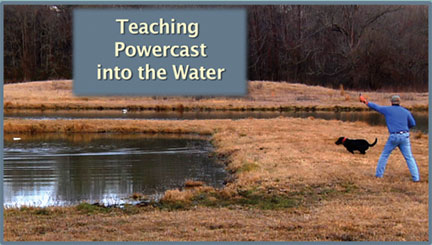 TEACHING POWERCAST INTO WATER TEACHING POWERCAST INTO WATER
In this review of Powercast Bill explains: “The collar is used to reinforce a command the dog is already doing, sit-nick-sit, or back-nick-back. The powercast is different in that it gets the dog to do something. It’s used, as an example, when a dog is sitting on the edge of the water that they haven’t gotten in the water on and you say ”over.” You are getting the dog to do something rather then reinforcing something they are already doing.
After going through the steps of Powercast Bill explains that it is not the irst thing you would do but it’s the thing that you use when you’re having some difficulty getting the dog to comply with what you want. There IS a conditioning process that must take place with the Powercast, always with a very low nick.
|
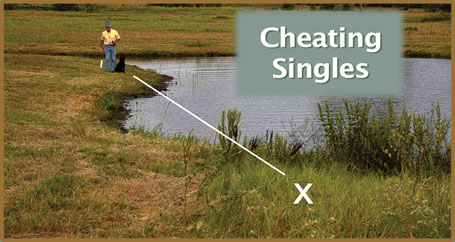 CHEATY SINGLES CHEATY SINGLES
Bill introduces cheaty water marks using hand thrown bumper, starting with the bumper fall being just past the corner of water. These hand thrown “corner” singles are followed by hand thrown “down the shore” marks, which is where he teaches the dog to go from Point A to Point B, without any deviation. He explains that the dog is “wondering what the heck is going on and my job is to make it clear to him.”
When the dog beaches early the sequence is the same - whistle/nick, call the dog back, whistle, cast toward the fall. “That’s what I don’t want, this is what I do want. In the next couple of weeks we’ll be spending hours on this topic.” After each session Bill keeps the dog in balance with hand thrown marks and a walk. Once hand thrown cheaty marks are consistently good Bill likes to train on short cheaty marks using a thrower. You will start with short marks and getting longer as the dog progresses. Once a cheaty single is learned Bill likes to throw a bumper off line making the thrower thrown cheaty mark the memory mark of a double.. NEVER LET YOUR DOG THINK YOU ARE MAD AT HIM - BECAUSE YOU NEVER ARE.
|
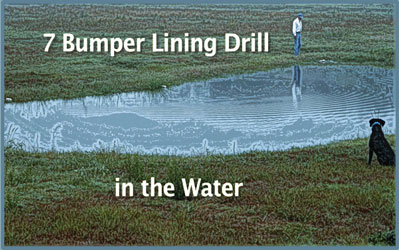 7 BUMPER LINING DRILL 7 BUMPER LINING DRILL
This drill teaches a dog to go straight, to look at a place and go in that direction, and to have proper alignment with your dog, the perfect heel position. You want your dog to look where YOU want him to look, and go where he is looking. “If you want to teach your dog to look OUT, then you
want to give him something to look AT, that’s how you begin.”
Bill demonstrates the develpment of this drill. Three different dogs emonstrate three different levels of training on this drill. Corrections are made with handling only. The only time you would use the collar on this drill is if the dog makes a mistake and you tried to stop/cast him and he refuses himself to be helped.
|
 WALKOUT BLINDS ON WATER WALKOUT BLINDS ON WATER
After your dog has done a single walkout land blind, a double walkout land blind, and they understand these pretty well you are ready to start a walkout water blind, granted you have done swim by and cutting cheaty corner and down the shore cheaty marks. Your first few should be with a simple entry.
On the walkout you are building a relationship, a powerhouse dog that can run a blind flat out and still be in control. The dog knows “There’s a bumper out there but doesn’t know exactly where it is, but he knows it’s out there.” You are using this as a chance to start to handle, not expecting accurate casting. The dog has confidence, power, they love it and this is the habit you want.
|
|